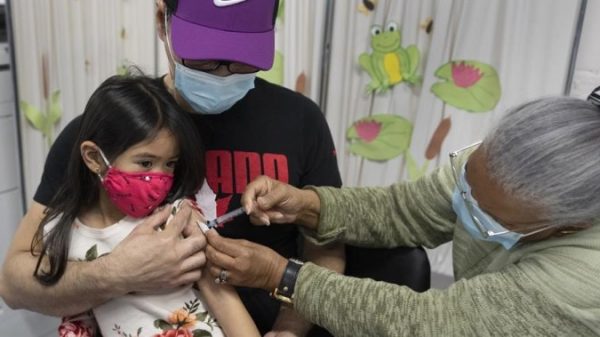With the threat of COVID-19 still looming, Canada’s Halloween on Sunday will once again look and feel quite different this year.
The day was scaled down and observed with caution across the country last year, but not completely cancelled.
Read more:
Majority of Canadians hesitant to hand out Halloween candy to trick-or-treaters: poll
As children get ready to go trick-or-treating door-to-door and adults gather for Halloween-themed parties, experts say the risk of COVID-19 transmission is lower this time around due to greater vaccination coverage. But precaution is needed to avoid a spike in cases.
“The risks are different this year in that most people are vaccinated and so we do have a much lesser risk for a lot of the older folks who might have been worried last year about opening their homes to kids,” said Dr. Fatima Kakkar, a pediatric infectious diseases specialist at the CHU Sainte-Justine in Montreal.

Kakkar said she does not expect a rise in pediatric cases, but infections among adults may increase in the weeks following the spooky weekend due to planned indoor gatherings.
“The ideal is to have masks and to limit the number of people and to really avoid the big Halloween parties because we’re not at that stage yet where we can do this without any kind of restriction,” she said.
Read more:
COVID-19: Most Cowessess First Nation cases involve kids, Halloween protocols in place
Costume masks should not replace surgical ones, Kakkar said, but also double-masking should also be avoided as it may make it difficult to breathe. Incorporating the face mask into your costume is the way to go, she said.
Kakkar also cautioned against painting or drawing over the masks to make them more colorful as this can release toxins and fumes which can be hazardous if inhaled.
Ventilation and distancing will also be key at indoor parties especially for those who are unvaccinated, the elderly and immunocompromised individuals, said Dr. Horacio Bach, an infectious diseases expert at the University of British Columbia.
How to trick-or-treat safely
Just like last year, many Canadians are hesitant to open their doors to trick-or-treaters.
According to a new survey this week by Leger and the Association for Canadian Studies, 56 per cent of respondents said they will not dole out candy on Halloween “given the current pandemic.”
Read more:
‘Keep it outside’: B.C.’s top doctor has advice for a safe, second pandemic Halloween
That same poll also showed that 93 per cent of Canadians whose kids trick-or-treated last year intend to have them go candy hunting again this Sunday.
Trick-or-treating is relatively safe because of the outdoor environment, where the risk of transmission is low due to greater ventilation, experts say.
“Kids going from house to house and in small groups and not in large congregate settings – that’s a relatively safe activity,” said Kakkar.

However, she advised limiting the duration of physical interactions, keeping masks on and not entering homes – no matter how cool or extravagant the Halloween decorations are.
“Keep it as much as possible outdoors,” she said.
And, if you’re concerned about contact with unvaccinated kids, Kakkar suggested leaving the candy outside to avoid exposure.
During collection, children should keep a hand sanitizer with them and sanitize or wash their hands before eating, said Bach. As always, parents should make sure the candy wrap is intact and discard it if it’s already opened.
Because the spread of COVID-19 from surfaces is minimal, disinfecting wrappers is not needed, both Kakkar and Bach said.
What provinces are saying
Amid a fourth wave of COVID-19 driven by the Delta variant, provinces have outlined different safety measures for Halloween.
In Ontario, the provincial government urged people to keep trick-or-treat interactions brief and outdoors as much as possible. Children should also refrain from singing, shouting and crowding doorsteps.
Read more:
Londoners gearing up for COVID-safe Halloween with trick-or-treating, Squid Game costumes a go
“Be creative and build the face-covering into your costume,” the province said on its website.
The pandemic forced several Toronto haunted houses, including Casa Loma’s Legends of Horror and Screemers, to remain shut last Halloween, however, both are welcoming visitors this year with safety protocols in place. Proof of vaccination is not required.

Last year, people used candy chutes, slides and tongs to deliver goodies with children standing further back than usual.
British Columbia’s health officer, Dr. Bonnie Henry, said she wants to see more of the same this year as children aged five to 11 won’t be vaccinated until after Halloween.
Read more:
Haunted house in Montreal’s South Shore helps realize sick children’s dreams
In Alberta, chief medical officer of health Dr. Deena Hinshaw stressed that this is not the year for large Halloween parties and reiterated the social gathering limits in place.
Indoor social gatherings at private households are limited to 10 people from two households and everyone eligible must be vaccinated. Indoor gatherings are not allowed for people who are not vaccinated.
In Quebec, kids are being asked not to yell “trick-or-treat” as they go door-to-door for candy and to keep a bottle of hand sanitizer handy this Halloween.
The province is also asking adults to hand out candies in individual bags and to respect the 10-person gathering limit when it comes to parties.

In Saskatchewan, health officials are urging residents in high-transmission areas to avoid indoor Halloween gatherings of any type, especially for the unvaccinated.
“We also ask that you consider alternatives to trick-or-treating,” Dr. Cory Neudorf, interim senior medical health officer for the Saskatchewan Health Authority said in a statement.
Read more:
Guelph Humane Society reminding pet parents to be vigilant on Halloween
Meanwhile, in Nova Scotia, residents are urged to offer food from pre-served single servings, or designate a single person to serve food and beverages during festivities.
The provincial government advised against ringing doorbells while trick-or-treating, saying kids should gently knock on doors instead. It also said not to take treats in situations where everyone has to reach into a single container.

— With files from The Canadian Press
© 2021 Global News, a division of Corus Entertainment Inc.














































